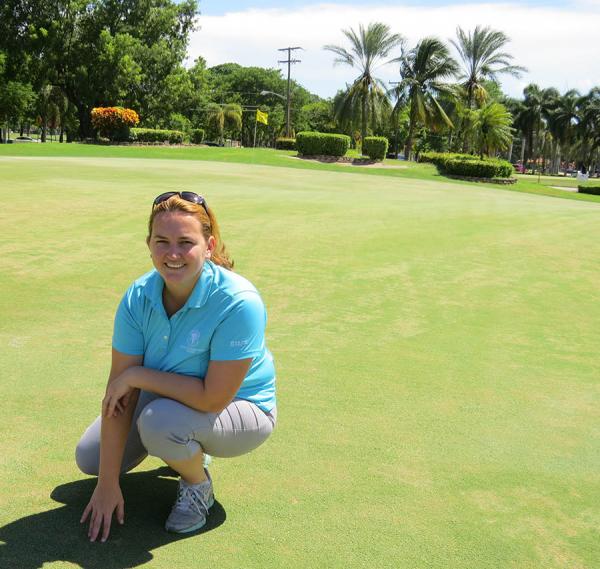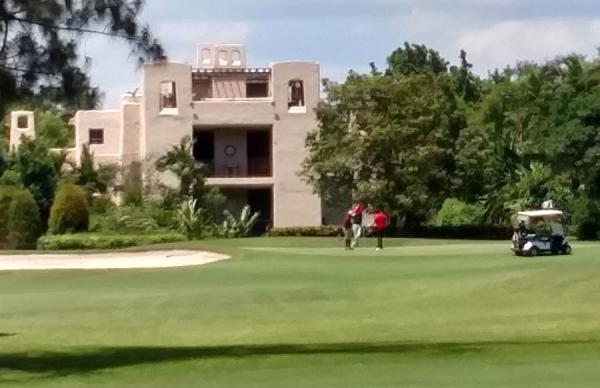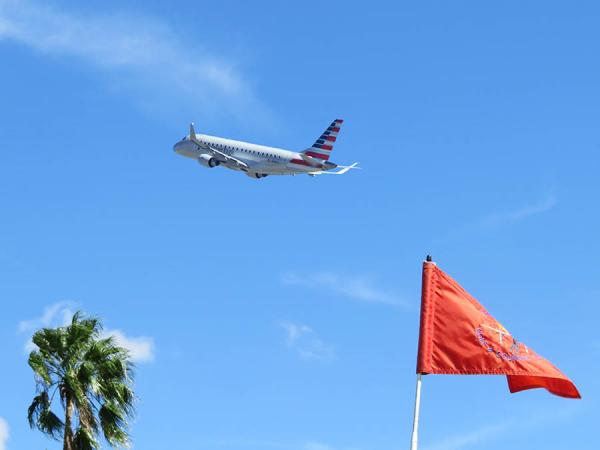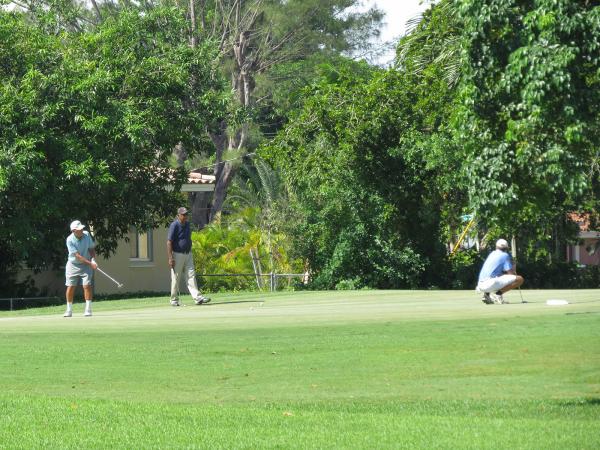Golf is a game inexorably linked to its past. It clings to and celebrates its history and former champions, living or dead, like no other sport.
Although football might be the nation's most popular sport, its early pioneers, like Sammy Baugh, Otto Graham and Jim Taylor, are not revered nearly in the way golf's greats, like Jones, Hogan, Snead and Nelson, or even Palmer and Nicklaus, are remembered.
 We embrace golf's venues and those who built them as icons. Augusta, East Lake, Merion, Medinah, Oakmont, Olympic and more stand the test of time in an era where football and baseball stadiums - with a few exceptions, i.e., Wrigley Field and Fenway Park - are razed to build new ones with more money-making luxury boxes. Even South Florida has its iconic tracks, and the Grand Dame of Miami-Dade is not the Biltmore or the Blue Monster at Doral, but Miami Springs, a 6,800-yard, tradition-rich layout that once was host to the longest tenured tournament in professional men's golf.
We embrace golf's venues and those who built them as icons. Augusta, East Lake, Merion, Medinah, Oakmont, Olympic and more stand the test of time in an era where football and baseball stadiums - with a few exceptions, i.e., Wrigley Field and Fenway Park - are razed to build new ones with more money-making luxury boxes. Even South Florida has its iconic tracks, and the Grand Dame of Miami-Dade is not the Biltmore or the Blue Monster at Doral, but Miami Springs, a 6,800-yard, tradition-rich layout that once was host to the longest tenured tournament in professional men's golf.To understand Miami Springs Golf Course, one must understand the community that has embraced it for nearly a century.
Opened in 1923, the city-owned course was built by Glenn Curtiss, a giant in aeronautics and civil rights before the latter was fashionable. Today, the course remains the oldest in the Miami area. Besides being a home for many years to an early professional tour event that regularly attracted the game's greats, the course,billed as one of the country's first desegregated golf facilities, also was the home of the annual North-South Tournament.
Superintendent Laurie Bland embraces her role at the course and its place in South Florida golf history.
"There is so much history here. Everybody used to play here," Bland said.
While the course has gone through a roller coast ride that saw it rise up, fall into disrepair only to rise up again, it shares many traits with the city, namely it is small, quaint, unpolluted by time and the envy of the metropolitan Miami area.
City-owned Miami Springs is tucked into a planned community of the same name that, with its triangular shape, is bordered by a canal to the west, 36th Street and the massive Miami International Airport to the south and the Miami River that connects the two from the northwest to the southeast before emptying into Biscayne Bay in downtown Miami 8 miles away.
The town, which cannot expand because of its hard boundaries, stands in contradiction to the growth, congestion and general hub-bub that have risen around it. To date, it has some of the highest real estate taxes - and real estate prices - in Miami-Dade County, is a reminder of the romance of early South Florida and proof that sometimes the more things change, the more they stay the same.
The course opened as the Miami-Hialeah Golf Club. It wasn't designed by MacKenzie or Ross, it was the work of Palmer . . . not that Palmer. Tub Palmer was a founding member of the Miami Coconuts, a group of South Florida golf aficionados seeking another place to play.
Residents of Miami Springs have been protective of the property ever since it went into the ground. Many of the town's residents are descendents of those who settled here on land once owned by Curtiss. When a hotel chain tried to buy a sliver of a city land adjacent to the golf course to complete a larger real estate purchase so they could build a hotel near the airport, residents voted it down by a two-thirds majority.
"People here love this golf course," Bland said. "They didn't want anyone building anything on land owned by this golf course."
 Like residents of the town he built, Curtiss, who later constructed a home on the golf course, was cut from a different cloth. Considered the father of naval aviation, his Curtiss Aeroplane and Motor Co. merged in 1929 with the Wright Brothers' Wright Aeronautical to form Curtiss-Wright, which still is in operation today. Once an airplane and engine manufacturer, today Curtiss-Wright, with sales of more than $2 billion in 2015, provides technology solutions for the defense, industrial, commercial aerospace and power-generation markets.
Like residents of the town he built, Curtiss, who later constructed a home on the golf course, was cut from a different cloth. Considered the father of naval aviation, his Curtiss Aeroplane and Motor Co. merged in 1929 with the Wright Brothers' Wright Aeronautical to form Curtiss-Wright, which still is in operation today. Once an airplane and engine manufacturer, today Curtiss-Wright, with sales of more than $2 billion in 2015, provides technology solutions for the defense, industrial, commercial aerospace and power-generation markets.Curtiss was a visionary who bought up scads of land in what is now Miami-Dade County, 116 acres of which he sold for the development of what today is Miami International Airport just south of Miami Springs.
When he paid nearly $100,000 to build the golf course, he used Seminole Indians as laborers, not to exploit them as a cheap source of labor, but to give them an opportunity for work because he could see they were a segment of the population that was being left behind as northerners swarmed into Florida in the early 20th century. Curtis, whose home on the golf course is being renovated into a museum, also established a bank just for the Seminoles.
"He could see they were being discriminated against," Bland said. "And he wanted to help them."
That ideology continued throughout the course's history.
From 1955-1989, the annual North-South Tournament was contested at Miami Springs. An integrated tournament that provided an outlet for play for black servicemen in the post-World War II era, the North-South events drew celebrity players such as Jackie Robinson, Joe Louis, Althea Gibson as well as professional golfers like Charlie Sifford, Lee Elder and Jim Dent.
By then, the course had developed a reputation as one of the country's top golf tracks, and was the site of professional golf's Miami Open from 1925 to 1955, which was the same year the original clubhouse was lost to a fire. Past winners there include Gene Sarazan, Sam Snead, Tommy Armour, Ray Mangrum and Frank Stranahan. Its run as the longest-tenured PGA professional event of its era ended in 1956 when the City of Miami, which then owned the course, refused to support the tournament. Major League Baseball players filled the void, and played in tournaments at the course each year during Spring Training from 1956-67.
The City of Miami Springs bought the course in 1997, and though a few tees and greens moved over time not much else had changed until Bland was named superintendent three years ago. The course had fallen into disrepair and lost more than $8 million since the ownership change, and golfers left for greener pastures.
When Bland arrived, the fairways had more weeds than turf. Some areas under heavy shade were so bad that nothing grew there and Bland, who prepped under Tom Trammell just a couple miles away at Doral, thought it might take years before she could make the course playable. During her interview, she told then-city manager Ron Gorland he would have to fork out a lot of money just to give golfers something they'd want to play.
"When I started here, the fairways were dead. I told the city manager it was going to take at least $1 million to get this place back in shape, including buying products you need," she said.
 She also delivered another dose of bad news.
She also delivered another dose of bad news."You're not going to get your money back. You're just not going to see that much revenue," she said. "You just need to get this place in shape first. If you put a million into a golf course don't expect to get it back. That's the kind of shape it was in. I told them to be ready to lose more money."
Eventually Bland whipped the course into shape through a program that included aggressive aerification and topdressing sand, as well as an herbicide program that comprised a lot of Xonerate, Revolver and Monument and what she described as "every ounce of Tribute available in South Florida."
"Everyone understood my gameplan," she said. "I had to attack the weeds and get those out of the way, and then the grass would come back. And it did with a lot of cultural practices, aerification and topdressing, and it worked."
Her plan and its implementation made city and course leaders happy they listened to her during the interview process.
"I refer to her quite often has my 'claim to fame.' What she has accomplished here in the three years we have been here is astonishing," said Miami Springs general manager Paul O'Dell, who took over management of the facility three months before he hired Bland. "This historic track was in shambles in many ways and she has brought the turf back to life, rebuilt all the tees, bunkers and aesthetics of this Grand Dame that is the oldest golf course in Miami."
Indeed. O'Dell, who was brought aboard to clean up the operation, has more than three decades of experience in the golf business and Bland already has been identified by city leaders as his eventual replacement whenever he decides to retire.
"In my years in the golf course business historically, it's (been) the head pro/director of golf (who has) ascended to the GM's position," O'Dell said. "Laurie will be one of the first to break that mold. She has the intelligences, demeanor and ability to direct all the departments and carry out all the functions of the general manager's position."
Since mid-July, Bland has been slowly integrating clubhouse duties into her schedule, including running the business end of the food and beverage department.
"I never knew there were so many laws, especially liquor laws," she said. "If you run out of Jack Daniels, you can't just go down to the local liquor store and buy a bottle. You have to buy it from a vendor.
"The trick is don't run out of Jack Daniels; make sure you keep it on hand. So far, we've been doing pretty good with that."
The entire city of Miami Springs is located atop the Biscayne Aquifer, and 22 well houses installed in the 1920s, including seven on the golf course, supply potable water to the City of Miami as well as Miami Springs. The sandy profile between the surface and the aquifer makes for a naturally efficient drainage system, something Bland learned early in her career there.
 Her first major rain event at Miami Springs came in July 2013, the same month she was hired. By the time the rain stopped late in the afternoon she had recorded 8 inches at the golf course.
Her first major rain event at Miami Springs came in July 2013, the same month she was hired. By the time the rain stopped late in the afternoon she had recorded 8 inches at the golf course.Rain in August in Miami is a common occurrence, but 8 inches is a lot, even here. That much precipitation can be especially troublesome on a course that relies solely on Mother Nature for drainage.
"There is no drainage on this course; absolutely none," Bland said. "The locals told me how well it drained. They said 'you'll see.' "
See it she did.
"When the rain ended around 5 p.m., the course, I mean it was just flooded," she said. "I thought, 'oh no, I'm going to have to shut it down tomorrow.' The next morning, I couldn't believe you could drive carts on the fairways, and we were able to reopen."
When the course was built, Tub Palmer didn't install a lot of bunkers, and most of the ones he did pencil into the design were pretty small. Since getting Springs' weed problem under control and bringing back the Bermuda turf in the fairways, Bland has rebuilt the bunkers and reduced the overall number of traps from 38 to 26, mostly by enlarging and combining them so there are fewer hazards to maintain.
"What is one bunker now used to be three small bunkers with big, deep faces. We don't need that here. It doesn't fit on this kind of golf course," she said.
"The course already is challenging because of the greens. We want to challenge golfers, but we also want to attract people and encourage them to play golf, so we needed to make the bunkers easier and easier to maintain. Now, I only have to send one person out in the morning to rake bunkers."
Some of those golfers who left when the course went to pot have never come back, though many have, enough to keep a steady stream coming through the door, even in 98-degree heat with soaring humidity.
Convincing many of them to give Springs another chance has taken some effort.
"It took a lot of work to convince them that we had changed and to come back," she said. "We offered them free golf or to just ride the course and see what they think.
"A lot of them didn't come back, but a lot did."
Those who did realized that at Miami Springs, the more things change, the more they stay the same.

